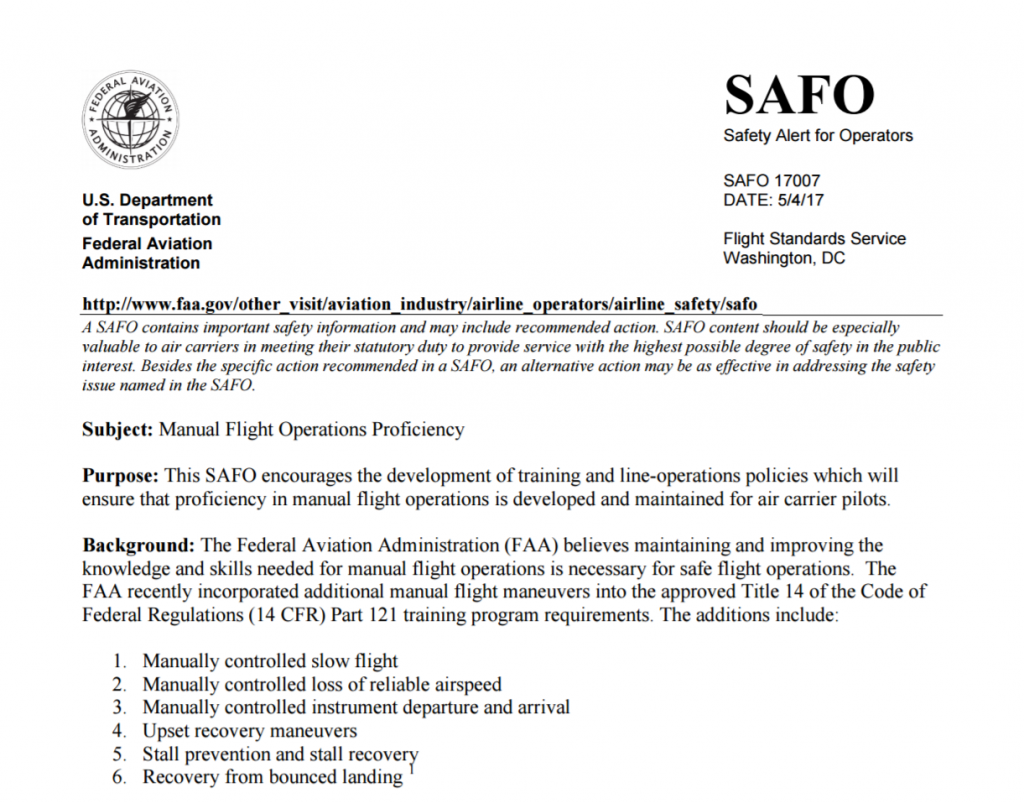 What is a SAFO?
What is a SAFO?
From the FAA website: “A Safety Alert for Operators (SAFO) is an information tool that alerts, educates, and makes recommendations to the aviation community. This community includes air carrier certificate holders, fractional ownership program managers, and 14 CFR Part 142 (flight simulator) training centers.”
The FAA issues numerous SAFOs each year, and it is recommended that, especially air carriers, pay special, timely heed to each SAFO in order to “to provide service with the highest possible degree of safety.”
What do SAFOs have to do with the average pilot, training center or flight department?
While the main audience for SAFOs is air carries and certain types of training centers, much of what is recommended by the FAA is of value to pilots of all types and can be highly valuable to flight departments. The FAA may require a higher level of oversight for air carriers, but SAFOs are generally conveying messages with enough significance that there are benefits to a broad swath of aviation for whom that safety information may be relevant.
How do the most recent SAFOs relate to Upset Prevention & Recovery Training (UPRT)?
As a UPRT provider, APS takes special note and makes every effort to inform our customers about relevant content in SAFOs. The FAA has recently released several SAFOs which directly relate to pilot safety and Upset Prevention & Recovery Training:
—————————————————–
SAFO 17009 on Airman Certification Standards (ACS): Slow Flight and Stalls updates both private and commercial pilots on changes to the evaluation standards for the slow flight task and certain stall tasks. These updates are targeted to help ensure that pilots are acquiring the knowledge and skills they need to prevent Loss of Control In-flight (LOC-I), the leading cause of fatal general aviation accidents. The updates specifically addresses slow flights and stalls, which are the most common situations in which pilots experience a loss of control in flight.
How does this SAFO relate to UPRT?
Upset Prevention & Recovery Training also directly addresses these critical situations and aids pilots not only in learning the ground training and practical skills necessary to overcome LOC-I, but also in practicing the skills sufficiently to help ensure retention and the ability to execute the proper inputs even in a critical situation where startle or fear could hinder proper recovery of the aircraft.
—————————————————–
SAFO 17008 on Attitude Indicator Pitch Indication Limitations “serves to notify aircraft operators of potential operational limitations of some attitude indicators in the event of unusual attitude recovery as recommended by National Transportation Safety Board (NTSB) Safety Recommendation A-14-108.”
How does this SAFO relate to UPRT?
Limitations of certain attitude indicators pose a threat to pilot safety, and can even confuse a pilot during an unusual attitude recovery. Pilots should be aware of the their instrumentation, and additionally, Upset Training allows pilots to develop the skills necessary to recover from an unusual attitude, as well as understand their instrumentation’s limitations and normal functionality in extreme attitudes.
—————————————————–
SAFO 17007 on Manual Flight Operations Proficiency encourages the development of training and line-operations policies which will ensure that proficiency in manual flight operations is developed and maintained. It suggests a number of different approaches which pilots can use to enhance manual flying proficiency, but perhaps the most beneficial is the practice of upset recovery maneuvers, including stall prevention and recovery.
How does this SAFO relate to UPRT?
Unlike standard flight training which segregates unusual attitudes and stalls, upset recovery addresses all conditions which may be encountered in an unexpected aircraft upset, including combinations of stalls and extreme attitudes, which are often precursors to Loss of Control In-flight (LOC-I) accidents. LOC-I is listed by the NTSB as the leading cause of fatalities in every sector of aviation.
Comprehensive and effective UPRT can help prepare pilots in advance to recover from upset events, but more importantly the awareness and pattern recognition developed through proper UPRT can aid prevention of LOC-I by developing the mental modeling, insight and discipline necessary to see the development of potential upset conditions and stop them from escalating.
Perhaps most importantly, the improved manual handling proficiency developed through UPRT is not only helpful in an undesired aircraft state, it helps pilots fly more accurately and confidently even in the heart of the normal envelope where we all hope to stay.




Comments: